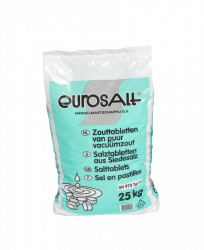Salt in Belgium
Belgium, or the Kingdom of Belgium in full, is a Western European country that lies on the North Sea and borders the Netherlands, Germany, Luxembourg and France. The country is 30,528 km² and has a population of just over 11 million. The most important city is Brussels, capital of Belgium and also administrative centre of the European Union and NATO.
The country has three official languages: about sixty percent of the population speaks Dutch, especially in Flanders, forty percent speaks French, especially in Wallonia, and less than one percent speaks German, in the East Cantons. The country's cultural and linguistic diversity has led, through a succession of state reforms, to a complex political system in which, in principle, fundamental competences - such as the economy, employment and public works - lie with the Regions (Flemish, Walloon and Brussels), and personal matters - such as education, culture and welfare - with the Communities (Flemish, French and German-speaking), with an overarching federal government for the entire territory, responsible for, among other things, defence, justice and social security.
Road salt is also a generally accepted de-icing agent in Belgium. It lowers the freezing point of water. The salt (almost always sodium chloride, NaCl, sometimes calcium chloride, CaCl2) mixes with the water present (ice or snow) to form brine. Because brine has a lower freezing point than water, it will freeze less quickly so that less slipperiness occurs. After sprinkling salt, there must be sufficient traffic to get a good mixture. Brine is a mixture of water and salt. When a substance is dissolved in water, the freezing point of the solution drops. For example, if water contains 1 molal of sodium chloride, the freezing point will be lowered by about 1.86°C. The freezing point reduction can be calculated using cryoscopic constant. At lower and lower temperatures sodium chloride becomes less effective. To still melt ice, calcium chloride can be used, which is however much more expensive.
Wet salt in Belgium
Nowadays wet salt is mostly used. In that case, the spreading machine is equipped with liquid tanks (usually on the side), in which pre-mixed brine is stored. The dry salt is mixed with brine before it is released, where the salt grains clump together. The advantage of this is that the mixture is more homogeneous than dry salt, allowing it to be scattered much more accurately. In addition, much less dust is created behind the spreader. It is therefore possible for the spreader to drive faster, up to 70 km/h (against a maximum of 40 km/h with dry salt spreading). Wet salt also adheres better to the road surface due to crystallization and because wet salt blows less quickly, it is also suitable for preventive spreading.
Effects of brine in Belgium
Spreading salt is not without risk. For example, car bodies need to be well protected against oxidation because brine reacts strongly with metals.
Another influence is the salinization of the soil next to the road, which affects the flora's environment. For example, salt-loving plants, such as English grass, can be found along many roads, far from the coasts where they are normally found.
However, due to increasingly sophisticated equipment and new techniques, such as wet salt spreading, the accuracy with which the salt is brought onto the road has been greatly increased in recent years, which has resulted in a lower environmental impact. Not only is the dosage used a lot lower than before (often only 10 g/m2 is spread), also much less is spread on the verge.




